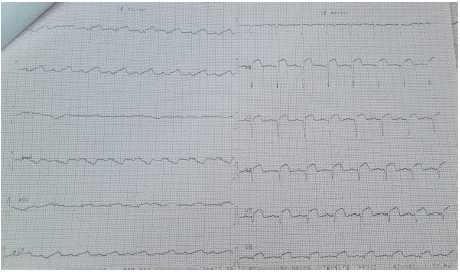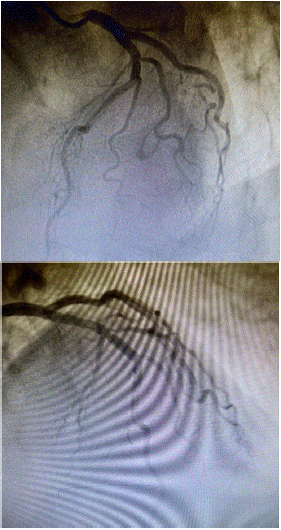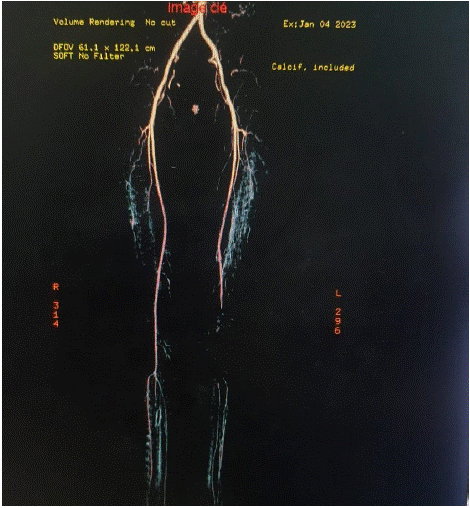
Case Report
Austin J Cardiovasc Dis Atherosclerosis. 2024; 11(1): 1064.
Acute Coronary Syndrome Unveiling Multiple Myeloma: A Case Report
Jihane Fagouri¹; Youssef Lahmouz²*; Nikiema Soumaila²; Hanae ELghiati¹; Jaouad Nguadi¹; Meryem Bennani¹; Driss Britel²; Zakariae Lahlafi²; Hicham Faliouni²; Abdelilah Benelmekki¹; Jamal Kheyi¹; Hicham Bouzelmat¹; Zouhair Lakhal²; Ali Chaib¹; Aatif Benyass³
1Department of Rythmology, Cardiology Center, Mohammed V Military Instruction Hospital of Rabat, Mohammed V University, Morocco
2Intensive Cardiac Care, Cardiology Center, Mohammed V Military Instruction Hospital of Rabat, Mohammed V University, Morocco
3Cardiology Center, Mohammed V Military Instruction Hospital of Rabat, Mohammed V University, Morocco
*Corresponding author: Youssef Lahmouz, Intensive Cardiac Care, Cardiology Center, Mohammed V Military Instruction Hospital of Rabat, Mohammed V University, Morocco. Email: lahmouzyoussef903@gmail.com
Received: October 10, 2024; Accepted: October 30, 2024 Published: November 06, 2024
Abstract
Introduction: Arterial thrombosis can rarely result from multiple myeloma without atheromatous participation.
Case report: We report a case of a 73 years old male patient who presented to the emergency department after four hours of infarct-like thoracic pain related to an anterior STEMI. The coronarography showed a thrombosis of the left anterior descending coronary artery with no atherosclerotic plaques or stenotic lesions in either the left or the right coronary systems. The evolution was marked by the occurrence of acute ischemia of the lower limb a few weeks later. Later Investigations demonstrated that the patient suffered from a multiple myeloma, treated with antalgics and chemotherapy.
Discussion: Multiple myeloma is associated with a venous thrombosis risk as well as an arterial thrombosis risk. The management is quite challenging due to the risk of bleeding while giving antiplatelets therapy. But we recommend a close follow up without restricting the treatment based on the ESC guidelines.
Conclusion: Arterial thrombosis in multiple myeloma is a reality and is supposed to be managed according to the ESC guidelines with close follow up given the risk of bleeding.
Keywords: Acute coronary syndrome; Lower limb ischemia; Multiple myeloma; Arterial thrombosis
Introduction
Patients with Multiple Myeloma (MM) have a high risk of venous as well as arterial thrombosis [1,2]. Though cases of venous thrombosis are common in this pathology, arterial thrombosis cases are rarely described [3]. As multiple myeloma is often diagnosed in the elderly patients, they also have cardiovascular risk factors exposing them to atheromatous disease such as myocardial infarction.
We report a case of arterial thrombosis that appears to be directly related to the multiple myeloma itself and not to an atheromatous origin.
Case Report
73-years-old male patient with no previous history of cardiovascular disease, with cardiovascular risk factors including hypertension, diabetes and dyslipidemia, who presented 4 hours before admission a constrictive, intense, prolonged, retro-sternal chest pain radiating to the left shoulder.
Upon admission, physical examination was unremarkable, with blood pressure at 135/75 mmHg and heart rate at 100 beats per minute, apyretic. The Electrocardiogram (EKG) revealed an STsegment elevation with a convex appearance in the anterior territory (Figure 1). Acetyl salicylic acid 300 mg and clopidogrel loading dose of 600 mg is given as antithrombotic agents and enoxaparin 0.6 mg two times daily for anticoagulation.

Figure 1: 12 derivations EKG showing a STEMI in the anterior extended
leads with Q waves of necrosis.
The patient was promptly admitted to the catheterization laboratory and the coronary angiography, performed via the femoral artery access, revealed a mobile thrombosis of the left descending artery coronary, with no significant atheromatous lesion (Figure 2). The patient received medical treatment based on unfractionated heparin, tirofiban, Clopidogrel and Aspirin. Thromboasipiration succeeded to recanalize this occlusion. Coronography of control within 48h showed the dissolution of the thrombus Transthoracic echocardiography showed Akinesia of the apex and adjacent segments, severe hypokinesia of the septal wall, with an ejection fraction of 48%. The biological assessment showed a troponin level of more than 1000 times normal and normochromic anemia with Hemoglobin at 10.3 g/dl.

Figure 2: Coronarography revealed a mobile thrombosis of the left
descending artery coronary, with no significant atheromatous lesion.

Figure 3: Angiography showing an abrupt arrest of the contrast agent
suggesting an acute occlusion of the artery.
Physical examination was unremarkable apart from pain localized on the lower back when pressure was exerted. X-ray examination of skeletal structures revealed lumbar vertebrae fractures of L1, L2, and L3. Blood test results showed a hypercalcemia of 3.45 mmol/L, C- reactive protein of 41 mg/L, haemoglobulin level stepped down from 10 g/dl to 6 g/dl, mean cell volume of 105 fl, platelet count of 221×109/L and a leucocyte count of 7,4×109/L. Subsequently, tested protein electrophoresis of blood and urine showed no monoclonal protein or Bence-Jones proteinuria. Monoclonal kappa-light chains were present in urine at electrophoresis. Bone marrow biopsy revealed 68% plasma cells. Immunophenotyping showed a wide- spread monoclonal plasma cell population. This woman was diagnosed with non-secreting multiple myeloma (MM), Salmon–Durie stage IIa.
Hypercalcemia was treated with bisphosphonates and intravenous fluids. The pain was controlled with opiates. Treatment of multiple myeloma was started with vincristine, doxorubicin and dexamethasone.
Discussion
Multiple myeloma is a plasma cell malignancy in which monoclonal plasma cells proliferate in bone marrow, resulting in an overabundance of monoclonal paraprotein (M protein), destruction of bone, and displacement of other hematopoietic cell lines [4]. Multiple myeloma is often discovered through routine blood screening when patients are being evaluated for unrelated problems. In one third of patients, the condition is diagnosed after a pathologic fracture occurs, usually involving the axial skeleton [5].
Patients with multiple myeloma have a high risk of arterial and venous thrombosis, which is hypothesized to be due to the interplay of patient comorbidities, therapy, and tumor-related factors. Venous thrombosis in multiple myeloma is quite common. Up to a third of these individuals may develop venous thrombosis if not given the benefit of prophylaxis [6].
However, arterial thrombosis is rarely found in the literature.
Abdul Rahman Al Armashi and al conducted a study to assess the risk of stroke and myocardial infarction in the population of patients with multiple myeloma. It was a huge study including more than 70 million people with 67 920 patients with multiple myeloma and has revealed that the risk of stroke was significantly higher in the multiple myeloma group compared to patients without multiple myeloma (OR 1.51, 95% CI 1.43-1.59) and the risk of myocardial infarction was also significantly higher among patients with multiple myeloma (OR 1.36, 95% CI 1.32-1.39) [7].
This study corroborates the case of our patient that presented both myocardial infarction and inferior limb acute ischemia. Moreover, Z M Galeeva and al reported a case of repeated episodes of acute coronary syndrome in a patient with multiple myeloma [8].
While thrombosis can be observed in all stages of the disease, its risk is particularly high in patients taking immunomodulatory drugs in combination with dexamethasone [6].
Survival in patients with Acute Coronary Syndrome (ACS) who also have a Hematologic Malignancy (HM) is markedly lower than in patients without a HM, and diagnosis with ACS and Multiple Myeloma (MM) was associated with the worst survival outcomes, according to a real-world analysis [9].
The management of ACS in patients with multiple myeloma is a clinical challenge, particularly due to the unique pathophysiology, which makes it difficult to balance thrombotic and bleeding risks in this specific patient population. In a real-world study conducted by Stefan A. Lange and al, it has been found that patients with hematologic malignancies and acute myocardial infarction had a lower prescription rate for all medications recommended in the guidelines.
Nevertheless, the prescription of antiplatelets is found to be equivalent with the population without hematologic malignancies.
Patients with cancer have largely been excluded from ACS trials. Hence, an evidence-based treatment for ACS in this group of patients is unknown and only a limited proportion of them is treated with antiplatelets or invasive revascularization, despite initial reports suggesting their beneficial prognostic effects in cancer patients [10].
In practice, we suggest first of all to exclude an atheromatous origin of the ACS and in case there is no atheromatous lesion to proceed to the administration of double antiplatelet therapy associated to anticoagulant agent with close follow-up.
Conclusion
Multiple myeloma can be associated with arterial thrombosis either from an atheromatous origin or as a complication of the disease itself. The main challenge of this association is therapeutic. It remains difficult to balance the bleeding risk with the thrombotic risk while giving antiplatelets or anticoagulants. We suggest the myocardial infarction be treated according to the ESC guidelines with a very close follow-up.
References
- Mateos MV. Management of treatment-related adverse events in patients with multiple myeloma. Cancer Treat Rev. 2010; 36: S24–32.
- Libourel EJ, Sonneveld P, van der Holt B, de Maat MPM, Leebeek FWG. High incidence of arterial thrombosis in young patients treated for multiple myeloma: results of a prospective cohort study. Blood. 2010; 116: 22–6.
- Zangari M, Barlogie B, Cavallo F, Bolejack V, Fink L, Tricot G. Effect on survival of treatment-associated venous thromboembolism in newly diagnosed multiple myeloma patients. Blood Coagul Fibrinolysis. 2007; 18: 595-8.
- Dimopoulos M, Kyle R, Fermand JP, Rajkumar SV, Miguel JS, Chanan-Khan A, et al, consensus recommendations for standard investigative workup: report of the international Myeloma Workshop Consensus Panel 3. Blood. 2011; 117: 4701-5.
- Dhaval Shah, et al. Multiple myeloma, Medscape, Hematology, drugs and diseases.
- Cesarman-Maus G, Braggio E, Fonseca R. Thrombosis in multiple myeloma (MM). Hematology. 2012; 17: S177-80.
- Al Armashi AR, Elantably D, Wang J, AI Zubaidi, Alkrekshi A. The Risk of Stroke and Myocardial Infarction in Multiple Myeloma: A Population-Based Study in the United States. Blood. 2022; 140: 7226–7227.
- ZM Galeeva, et al. myocardial infarction and multiple myeloma, russian journal of cardiology.
- Lange SA, Schliemann C, Engelbertz C, Feld J, Makowski L, Gerb J, et al. Survival of patients with acute coronary syndrome and hematologic malignancies—a real-world analysis. Cancers (Basel). 2023; 15: 4966.
- Milazzo V, Cosentino N, Campodonico J, Lucci C, Cardinale D, Cipolla CM, et al. Characteristics, Management, and Outcomes of Acute Coronary Syndrome Patients with Cancer. J Clin Med. 2020; 9: 3642.